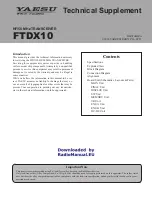
RT-2087/ZPX-A User and Installation Guide
UAV-1005667-001 Rev A
ECCN 7A994
Page 31 | 48
10.1.5
Aircraft Registration
The Aircraft Registration can be up to an 8 alpha-numeric code that
corresponds to the tail number of the aircraft.
Note: This is typically the civilian aircraft N-number or military equivalent,
unless otherwise advised by the FAA or ATC.
10.1.6
GPS Antenna Lateral / Longitudinal Offset
The GPS antenna offset is used in conjunction with the length and width to
manage taxiway conflicts. A typical GPS does not report the geographic
position of the center of the aircraft, or even the tip of the nose of the
aircraft; instead, it usually reports the location of the actual GPS antenna
(not the GPS receiver). In normal flight operation, this distinction is of no
importance at all, but if ADS-B is used to manage taxiway conflicts, a
significant offset in antenna position could mean the aircraft footprint is not
in the same place as the ADS-B reported position. Although the GPS
Antenna Offset is primarily intended for position correction on large
transport aircraft, General Aviation aircraft and some UAS can also have a
significant offset. For example, if the aircraft has a long tail boom and the
GPS antenna is on top of the tail, the GPS position could be 4 meters or
more from the nose of the aircraft.
GPS Antenna Lateral Offset
from roll axis (Meters)
GPS Antenna Longitudinal Offset from
aircraft nose (Meters)
0
0 to 60 meters in 2-meter increments
Left 2
Left 4
Left 6
Right 2
Right 4
Right 6
















































